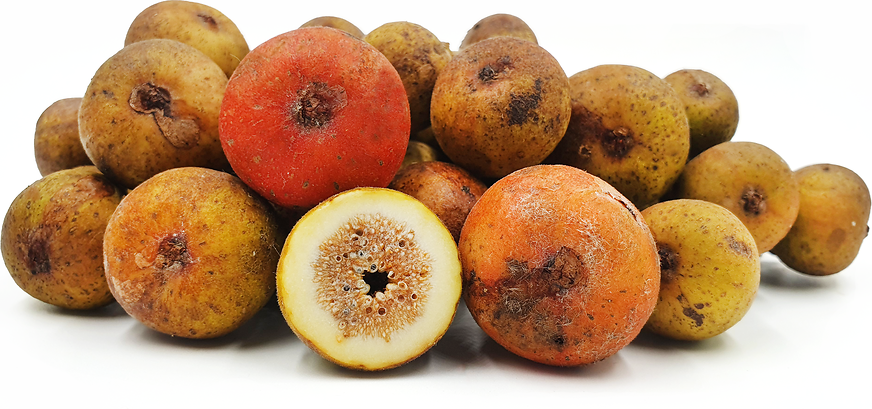


Cluster Figs
Estimated Inventory, lb : 0
Description/Taste
Cluster figs are small to medium fruits, averaging 2 to 5 centimeters in diameter, and are round, oval, to pyriform in shape. The fruits form in clusters of up to 20 fruits and grow directly from the tree’s trunk and branches. The skin is semi-smooth, delicate, and sometimes fuzzy, ripening from green to shades of orange, red-brown, and dark red when mature. Underneath the surface, the flesh is soft, tender, sticky, and pale yellow to white, encasing a central cavity filled with tiny, grain-like seeds that contribute a crunchy consistency. Cluster figs have an aroma similar to the smell of spiced apples and develop a neutral, very sweet, and subtly tangy taste.
Seasons/Availability
Cluster figs are available in the spring through early summer.
Current Facts
Cluster figs, botanically classified as Ficus racemosa, are wild fruits that grow on large trees reaching up to 30 meters in height, belonging to the Moraceae family. The variety has an expansive native region, spanning across Asia, Southeast Asia, and down into Australia, resulting in the fruits being known by many names, including Gular figs, Indian figs, Atti, Buah Loa, Lo fruits, and Elok. Cluster fig trees are highly ornamental as the fruits grow directly from the trunk and branches, developing an unusual appearance. In India, the trees are intentionally grown, planted in parks, home gardens, and temples, and the fruits are favored for their sweet taste, fast-growing nature, and nutritional properties, used in both culinary applications and medicinal remedies. Outside of India, Cluster fig trees are primarily found in the wild and are foraged on a small scale for culinary use. The tree’s large and thick roots are also frequently used to prevent erosion along riverbanks, and the widespread canopy is used to shade other plants on plantations.
Nutritional Value
Cluster figs are an excellent source of fiber to regulate the digestive tract and are high in calcium to strengthen bones. The fruits are also a good source of potassium to balance fluid levels in the body, riboflavin to produce energy, and iron to build the protein hemoglobin to transport oxygen in the blood. In Ayurveda, Cluster figs are used as an anti-inflammatory, cleansing, and blood purifying ingredient.
Applications
Cluster figs are best suited for both raw or cooked applications, including stir-frying, boiling, and roasting. The fruits can be consumed fresh, out-of-hand, but it is important to note that there may be tiny insects inside of the flesh. These insects are edible, but many consumers choose to open the fruits, remove the seeds, and cook the flesh to avoid eating the bugs. Cluster figs can also be pickled when young and used as a tangy side dish or condiment, or they can be stirred into soups and curries. When the fruits are mature, their sweet flesh can be simmered into jams, jellies, and preserves, mixed into stir-fries, or the flesh can be fried and served as an accompaniment to teas. Cluster figs can also be dried and eaten as a chewy snack, dried, ground into flour, and combined with milk and sugar as a sweet breakfast dish, or roasted, ground into a powder, and combined with flour to make a cake. In addition to the fruits, the tree's young leaves can be lightly cooked and served similarly to spinach. Cluster figs pair well with nuts such as walnuts, pistachios, and almonds, spices such as cardamom, cumin, garam masala, and coriander, yogurt, eggplant, and meats such as lamb, poultry, beef, and duck. Whole Cluster figs have a short shelf life and should be immediately consumed or dried for the best quality and flavor. Once harvested, the fruits will keep 2 to 3 days when stored in the refrigerator.
Ethnic/Cultural Info
Cluster fig trees are known as Udumbara in Sanskrit and are sacred trees intertwined with many legends and stories in the Hindu religion. The tree is most commonly associated with the guru or god Dattatreya, a deity believed to embody Vishnu, Shiva, and Brahma. Dattatreya is also known as one of the lords of yoga, and many different sectors of Hinduism worship the deity in the present-day. Throughout India, Udumbara trees are often planted in temples dedicated to Dattatreya, and some Hindus believe the god resides within the tree. In ancient times, Cluster figs were also a significant food source for traveling Hindus. The fruit trees were easily found along jungle paths, but there was a strict process for eating the fruits. Cluster figs commonly contain pollinating wasps and other insects, and the traveling vegetarians had to scrape out the seeds within the fruit and leave it to dry in the sun for an hour as a way to not ingest living creatures.
Geography/History
Cluster figs have a vast native region, including parts of Asia, Southeast Asia, Oceania, and Australia. The fruit’s tiny seeds were frequently spread through animal excrement in ancient times, leading the trees to become naturalized throughout tropical and deciduous forests extending into Africa. In the modern-day, Cluster fig trees are commonly found near water and are seen growing alongside riverbanks, swamps, and lakes. The fruits are primarily harvested from wild trees, but some trees may be found in home gardens for ornamental, medicinal, and religious purposes. Cluster fig trees can be found in India, Southern China, Myanmar, Thailand, Vietnam, Malaysia, Indonesia, Africa, Oceania, and Australia.
Recipe Ideas
Recipes that include Cluster Figs. One
| Ministry of Curry |
|
Fig Walnut Halwa |
| Cook Safari |
|
Gullar (Cluster Fig) ki Sabzi |
| Cook With Reena |
|
Cluster Fig Curry |
| Archana's Kitchen |
|
Shallow Fried Cluster Fig |
| Banaras Ka Khana |
|
Gooler Ka Chokha |




